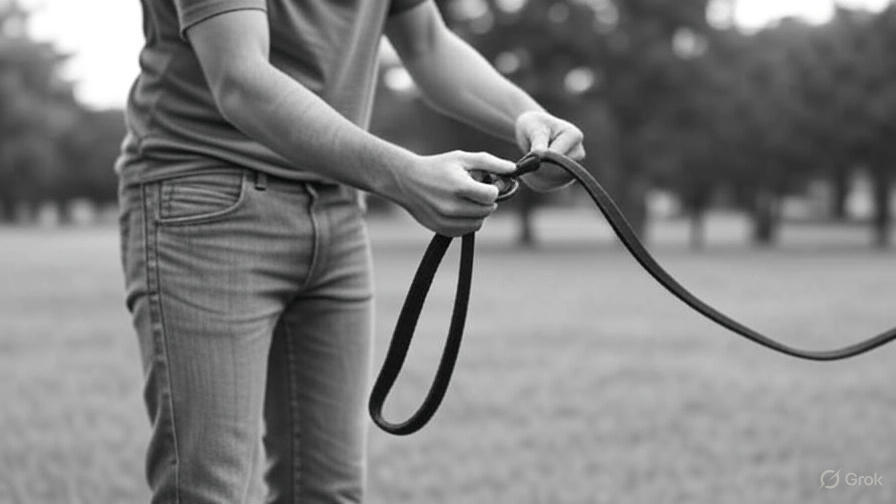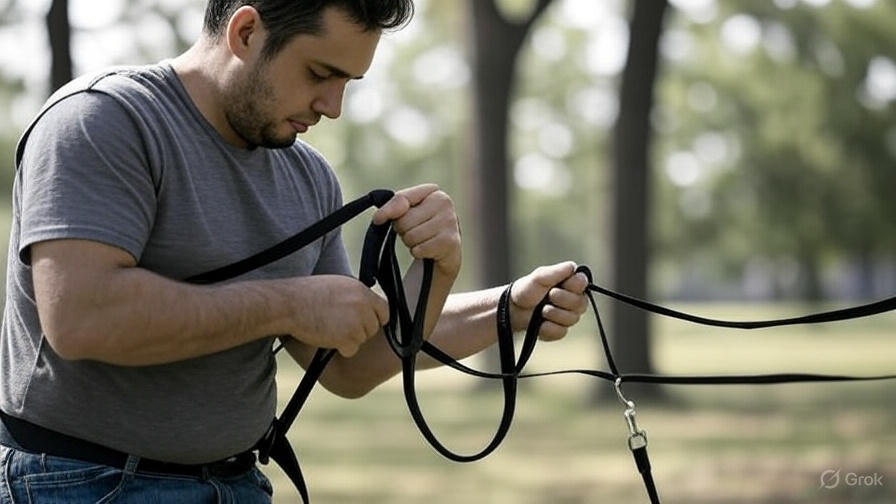How to Make a Harness Out of a Leash?
Dog owners often find themselves in situations where their regular harness breaks or gets lost during walks. Instead of cutting your adventure short, you can transform any standard leash into a functional walking harness for your furry friend. This clever trick works well for emergency situations and provides a safe alternative when your usual gear isn’t available.
Converting a leash into a harness requires basic knowledge of knot-tying and proper positioning. The process takes just a few minutes and uses the same leash you already carry. This method proves especially useful during travel, unexpected situations, or when you need a backup solution for your pet’s safety.
Why Transform Your Leash Into a Harness?
Harnesses distribute pressure across your dog’s chest rather than concentrating force on their neck. This design reduces strain on the trachea and prevents potential breathing problems that can occur with traditional collar-and-leash combinations. Many veterinarians recommend harnesses for dogs with respiratory issues, neck sensitivity, or pulling habits.
Emergency situations call for creative solutions. Your dog’s regular harness might break during a hike, or you could forget it at home during a spontaneous trip to the park. Converting your leash into a makeshift harness keeps your pet secure and gives you peace of mind in these moments.
The technique also works well for dogs who have learned to slip out of regular collars. A properly configured leash harness creates multiple contact points that make escape much more difficult. This added security proves invaluable for anxious dogs or those prone to sudden movements.
Budget-conscious pet owners appreciate this method as a temporary solution. High-quality harnesses can cost significant money, and this approach lets you test whether your dog prefers harness-style walking before making a purchase.
Materials and Tools You’ll Need
The beauty of this method lies in its simplicity. You need just a few basic items that most dog owners already have on hand. A standard 6-foot leash works best for this conversion, though shorter leashes can work for smaller dogs.
Your leash should have a comfortable handle and a secure clip. Leather, nylon, and rope leashes all work well for this purpose. Avoid retractable leashes, as their mechanisms don’t provide the stability needed for harness conversion.
Some situations benefit from having a few optional items available. A small carabiner or additional clip can help secure the configuration, though it’s not essential. Soft fabric or padding can make the improvised harness more comfortable for sensitive dogs.
Step-by-Step Instructions for Basic Leash Harness
Start by laying your leash flat on the ground to visualize the process. This preparation helps you understand how the final configuration will look and feel on your dog.
Create the chest loop first. Hold the leash about two feet from the clip end and form a loop large enough to fit around your dog’s chest, just behind their front legs. The size of this loop depends on your dog’s measurements, so estimate generously at first – you can adjust later.
Thread the handle end of the leash through this chest loop from underneath. Pull it through until you have enough length to create a second loop that will go around your dog’s body behind their front legs and under their belly.
Form the belly loop by taking the remaining leash length and creating another circle. This loop should be slightly smaller than the chest loop and will sit under your dog’s belly area. The handle should extend beyond this second loop to give you something to hold during walks.
Test the fit by gently placing the harness on your dog. The chest loop goes over their head and sits across their chest, while the belly loop encircles their body behind the front legs. Adjust both loops by sliding the leash material to achieve proper sizing.
The clip end of the leash should hang down from the chest area, ready to attach to your regular leash or to use as a short lead. This configuration distributes pulling force across your dog’s chest and under their body rather than concentrating it on their neck.
Advanced Figure-8 Technique
The figure-8 method creates a more secure and comfortable harness design. This technique works particularly well for dogs who pull strongly or try to back out of simpler configurations.
Begin by folding your leash in half to find the midpoint. This center point will become the connection area that sits on your dog’s back between their shoulder blades.
Create the first loop of the figure-8 by bringing one end of the leash around to form a circle. This loop will go around your dog’s neck, sitting lower than a traditional collar position – more like where a harness chest strap would rest.
Form the second loop by taking the other end of the leash and creating another circle that intersects with the first. These two loops should cross over each other at the midpoint you identified earlier, creating the classic figure-8 shape.
Adjust both loops to appropriate sizes for your dog. The neck loop should be loose enough to fit comfortably but tight enough to prevent slipping over their head. The body loop goes around their chest behind the front legs.
Position the intersection point on your dog’s back, with one loop around their chest and the other around their neck area. The crossing point distributes pressure evenly and prevents the harness from sliding around during walks.
Safety Considerations and Proper Fit
Proper fit determines both comfort and safety when using a makeshift leash harness. The chest loop should allow you to slip two fingers underneath the leash material when it’s positioned on your dog. Too tight restricts breathing and movement, while too loose allows your dog to escape.
Check that the harness doesn’t ride up into your dog’s armpits or press against their throat. The configuration should distribute pressure across the broader chest area rather than concentrating it on sensitive spots.
Watch for signs of discomfort during your walk. Heavy panting, excessive pulling to one side, or attempts to paw at the harness indicate adjustment needs. Stop and reposition the loops if your dog shows any distress signals.
Avoid using this method for extended periods. Makeshift harnesses work well for short walks or emergency situations but shouldn’t replace properly fitted commercial harnesses for regular use. The improvised nature means less padding and potentially uneven pressure distribution over time.
Never leave a leash harness on an unattended dog. The temporary nature of this setup makes it less secure than purpose-built harnesses, and dogs left alone might work their way out of the configuration.

Different Leash Types and Their Applications
Rope leashes excel at harness conversion due to their flexibility and grip. The textured surface holds knots well and provides good control during walks. However, rope can be rougher against your dog’s skin, so monitor for any irritation signs.
Nylon leashes offer durability and comfort for most dogs. The smooth material slides easily during adjustment and doesn’t typically cause skin problems. Wide nylon leashes distribute pressure better than thin ones when converted to harness form.
Leather leashes provide excellent grip and become more comfortable with use. The natural material softens over time and molds slightly to your dog’s body shape. Quality leather leashes also tend to be stronger, which adds security to your improvised harness.
Chain leashes don’t work well for harness conversion. The metal links can pinch skin and don’t hold the loop shapes needed for proper fit. Stick with fabric-based leashes for this technique.
Bungee or elastic leashes can work but require extra attention to fit. The stretchy material changes length under tension, which can cause the harness to loosen during walks. Check the fit frequently if using this type of leash.
Troubleshooting Common Issues
Dogs who resist having the harness put on them need patient introduction to the process. Start by letting them smell and investigate the leash configuration before attempting to put it on. Reward calm behavior with treats to create positive associations.
Slipping occurs when the loops are too large or positioned incorrectly. Tighten the chest loop first, ensuring it sits snugly behind the front legs. The connection point should rest firmly on your dog’s back without sliding to either side.
Chafing can happen if the leash material rubs against your dog’s skin during movement. Wrap soft fabric around pressure points or shorten your walk time to prevent irritation. This problem occurs more often with rough-textured leashes.
Some dogs learn to back out of improvised harnesses by lowering their heads and pulling backward. Combat this by ensuring the chest loop fits snugly and the neck portion sits low enough to prevent easy escape. The figure-8 method works better for escape artists.
Tangling happens when the leash configuration becomes twisted during walks. Stop periodically to check that both loops maintain their proper position and aren’t crossing over each other in ways that restrict movement.
When to Use This Technique vs Regular Harnesses
Emergency situations call for leash-to-harness conversion. Broken equipment during hikes, forgotten harnesses during travel, or sudden need for better control all justify using this method. The technique provides immediate solutions when commercial options aren’t available.
Training scenarios sometimes benefit from improvised harnesses. You can test whether your dog responds better to harness-style walking before investing in expensive equipment. This trial approach helps determine if a permanent harness purchase makes sense for your pet.
Temporary situations like pet-sitting or borrowing a dog work well with leash conversion. You might not have the right size harness available, but you can adapt any suitable leash to provide safe walking control.
Regular daily walks deserve proper commercial harnesses. Purpose-built equipment offers better padding, more precise fit adjustments, and superior durability for frequent use. Use the leash conversion method as a backup rather than a permanent solution.
Very large or very small dogs present challenges for leash conversion. Giant breeds need commercial harnesses designed for their strength and size, while tiny dogs require precise fitting that’s difficult to achieve with improvised methods.
Tips for Different Dog Sizes and Breeds
Small dogs under 20 pounds need gentler handling during harness application. Use shorter leashes to avoid excess material that can tangle around their legs. The loops should be proportionally smaller but still allow comfortable breathing and movement.
Medium-sized dogs between 20-60 pounds work best with this conversion technique. Standard 6-foot leashes provide adequate material for proper loop sizing, and these dogs typically have body proportions that suit the method well.
Large dogs over 60 pounds require strong leashes and careful attention to fit. The improvised harness bears more stress with bigger dogs, so check all connection points frequently during walks. Consider this method only for short-term use with large breeds.
Long-bodied breeds like Dachshunds need special consideration for loop placement. The belly loop should sit further back to accommodate their extended torso, and the chest loop might need to be larger to account for their barrel-shaped rib cage.
Flat-faced breeds such as Bulldogs and Pugs benefit most from harness-style walking due to their breathing sensitivities. Take extra care with fit around the chest area to ensure unrestricted airflow during walks.
Narrow-chested breeds like Greyhounds can slip out of poorly fitted improvised harnesses more easily. Make the chest loop snugger than you might for other breeds, and consider the figure-8 method for added security.
Maintenance and Storage of Your Converted Setup
Clean your leash regularly when using it for harness conversion. The additional contact with your dog’s body means more exposure to dirt, sweat, and outdoor elements. Follow the manufacturer’s cleaning instructions for your specific leash material.
Inspect the leash for wear signs after each use as a harness. The bending and tension involved in harness configuration can stress the material differently than normal leash use. Look for fraying, weak spots, or hardware issues that could compromise safety.
Store the leash properly between uses to maintain its shape and integrity. Avoid leaving it in loops for extended periods, as this can create permanent kinks in some materials. Hang it straight or coil it loosely for storage.
Practice the conversion technique regularly so you can execute it quickly when needed. Muscle memory helps during stressful situations when your dog needs immediate secure control. Run through the steps periodically to stay proficient.
Keep a backup leash available if you frequently rely on this conversion method. Having two leashes allows you to create more complex harness configurations or provides redundancy if one leash fails during use.
Conclusion
Converting a leash into a harness provides dog owners with valuable flexibility and emergency options. This technique transforms standard walking equipment into a chest-distributing control system that’s safer and more comfortable than collar-only walking.
The methods outlined here work for temporary situations, emergency scenarios, and testing purposes. However, they shouldn’t replace properly fitted commercial harnesses for regular use. The improvised nature means less durability and potentially less comfort over extended periods.
Master these techniques before you need them. Practice with your dog at home in a controlled environment so you’re prepared when situations arise. Your dog will appreciate the gentler control method, and you’ll gain confidence knowing you can adapt to unexpected circumstances.
Remember that every dog responds differently to harness-style walking. Some dogs adjust immediately, while others need time to become comfortable with the different pressure distribution. Be patient during the transition and always prioritize your pet’s comfort and safety above convenience.
The ability to convert any leash into a functional harness represents practical problem-solving that every dog owner should understand. This skill enhances your preparedness and ensures your furry friend stays safe and secure regardless of what challenges your adventures might bring.







